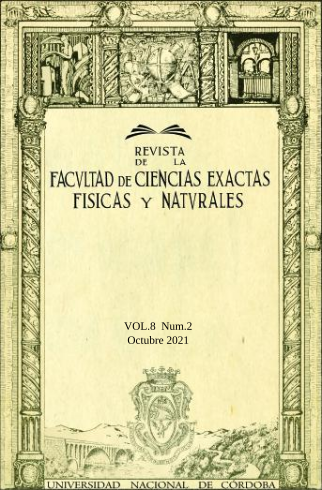Calibración del modelo VISSIM para el estudio de intersecciones en autovías de la Provincia de Córdoba
Keywords:
Simulation, Multilane highways, At grade returnsAbstract
The increase in vehicular transport led to the need to improve the road infrastructure of the Province of Córdoba. The authorities responded by the construction of multilane highways with at-grade returns. Currently, there are no studies that specifically analyze the operation of this type of device. The analysis was focused on the most widespread type of returns on local routes, whose design includes auxiliary lanes for the entry - exit of a secondary street, which is located centered with respect to two opposite U-turns, with a lane linking them, and with a rectilinear development of the lanes between turns. It was considered that the use of a traffic simulation model, properly calibrated and validated, allows a very wide variety of studies. This work describes the model used (VISSIM 8.0), the collection and processing of the information, the calibration with the network design, the assignment of traffic parameters, the behavior of the drivers, and finally, the validation of the model. The results obtained allow to conclude that the model, with the proposed adjustments, can be used satisfactorily to carry out traffic operation studies at the intersections of multilane highways of the Province of Córdoba.
Downloads
References
[1] Casares, A. (2015). “Calibración del modelo de seguimiento del software de micro simulación Vissim en carreteras multicarriles en régimen de flujo libre en Uruguay”. Tesis Maestría Mención Tranporte. FCEFyN. Universidad Nacional de Córdoba, Argentina.
[2] Depiante, V. (2010). “Giros a la izquierda en intersecciones no semaforizadas”. Tesis Maestría Mención Tranporte. FCEFyN. Universidad Nacional de Córdoba, Argentina.
[3] El Esawey, M. y Sayed, T. (2011). “Operational performance analysis of the unconventional median U-turn intersection design”. En Canadian Journal of Civil Engineering. NRC Research Press. doi:10.1139/L11-085
[4] López Mendoza, S. C. y Mesa Pabón, J. M. (2012). “Determinación de los parámetros de tránsito del corredor de la Autopista desde La Puerta del Sol hasta Quebrada Seca utilizando el programa Vissim”. Escuela de Ingenierías y Administración, Universidad Pontificia Bolivariana. Bucaramanga, Venezuela
[5] Lucas, C. B. (2008). “Quem Vai Cuidar do Nosso Tránsito”. Recuperado el 5 de 11 de 2018, de www.perkons.com.br
[6] Oliveira, V. D. (2009). “Estudo da capacidade de retornos localizados em canteiros centrais de vias urbanas para estimativa do comprimento da faixa de armazenamento”. Universidad de Brasilia, Brasilia, Brasil.
[7] Pájaro, A., y Quezada Narváez, R. (2012). “Modelación del tránsito vehicular en el sector Bomba el Amparo - Sao Plazuela por medio del software PTV Vissim”. Universidad Nacional de Colombia, Cartagena, Colombia.
[8] Pavani, B. (2008). “Comparitive study of type 2 median crossovers and median u-turns”. University of Missouri,Columbia, USA.
[9] Solberg, P. y Oppenlander, J. (1996). “Lag and gap acceptances at stop controlled intersections” en Highway Research Record 118, 48-67
[10] Tian, Z., Kyte, W., Vandehey, M., Robinson, B., Kittelson, W., Troutbeck, R., y Brilon, W. (1999). “Implementing the Maximum Likelihood Methodology to Measure”. En Transportation Research, 187–197.
[11] TRB. (2016). “HIGHWAY CAPACITY MANUAL”. Transportation Research Board. Washington D.C.: National Academy of Sciences.
[12] Turki I. , A.-S. O., y Mohammad S. , E. (2013). “Gap Acceptance Behavior at U-turn Median Openings– Case Study in Jordan”. En Jordan Journal of Civil Engineering, vol. 7, n° 3.
[13] Autor X. (2020).
Downloads
Published
Issue
Section
License
Copyright (c) 2021 Facultad de Ciencias Exactas, Físicas y Naturales (Universidad Nacional de Córdoba)

This work is licensed under a Creative Commons Attribution 4.0 International License.
Los autores que publican en esta revista están de acuerdo con los siguientes términos:
Los autores conservan los derechos de autor y conceden a la revista el derecho de la primera publicación.
Los autores pueden establecer por separado acuerdos adicionales para la distribución no exclusiva de la versión de la obra publicada en la revista (por ejemplo, situarlo en un repositorio institucional o publicarlo en un libro), con un reconocimiento de su publicación inicial en esta revista.
Se permite y se anima a los autores a difundir sus trabajos electrónicamente (por ejemplo, en repositorios institucionales o en su propio sitio web) antes y durante el proceso de envío, ya que puede dar lugar a intercambios productivos, así como a una citación más temprana y mayor de los trabajos publicados (Véase The Effect of Open Access) (en inglés).



